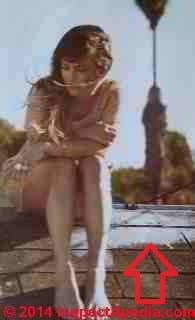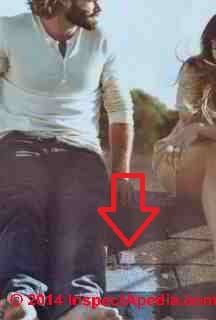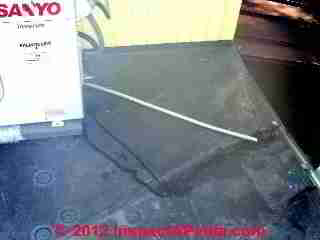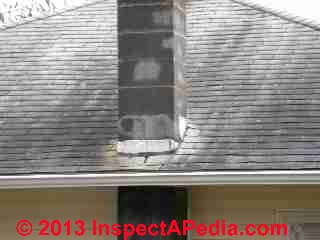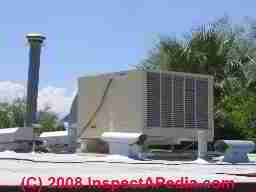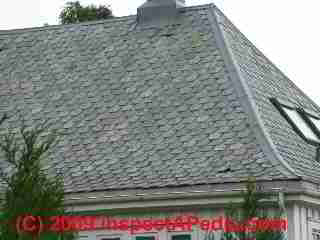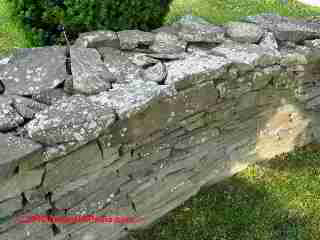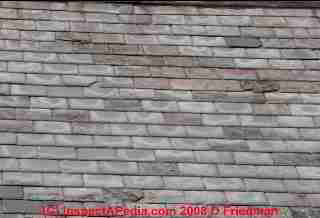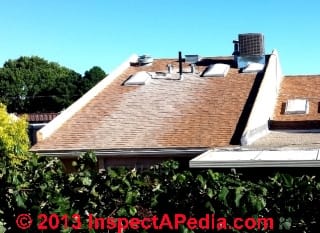 White Stains on Roof Surfaces
White Stains on Roof Surfaces
How to diagnose & remove white staining or deposits on roofs
- POST a QUESTION or COMMENT about how to determine the source of white or light colored stains on building roofs & how to remove stains from roof surfaces
White stains on building roofs: this article describes the causes & cures for white stains or white deposits on building roofs. We describe common causes of white blotches or staining on roofs of different materials: asphalt shingle, wood shakes or shingles, stone roofs & slate roofs.
We discuss roof cleaning approaches using chemicals and the most gentle possible means so as to avoid damaging the roof and to reduce the risk of chemical burns or of building or plant damage from chemical wash-down onto lower surfaces during the roof cleaning process.
Page top photo of white staining on a roof in Albuquerque NM courtesy of reader Joe Miceli, Clean Right Commercial, and Residential Pressure Washing Email: Miceli571@gmail.com - 2013
InspectAPedia tolerates no conflicts of interest. We have no relationship with advertisers, products, or services discussed at this website.
White Stains on Roof Surfaces: a catalog of roofs & white stains, causes & cures
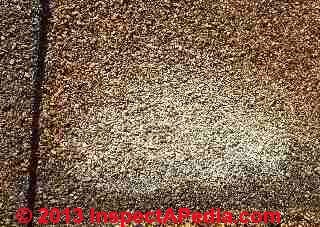 Article Contents:
Article Contents:
White Stains from Paint Spills on Roofs
First let's get this out of the way. We adapted the following two photographs of white blotchy roof stains from an advertisement in an Air New Zealand flight magazine.
Below the first image of the ad section showed white roof staining that was unexplained and that no doubt escaped the interest of the ad copywriter.
But a closer look at the same advertising photograph of two people sitting on a roof (don't ask what they were doing up there in the New Zealand sun) shows (at above right) what is rather evidently a white splash that looks like nothing other than a spill of white paint on the roof.
A Kiwi would have figured this out right away.
White Stains on Asphalt Shingle Roofs
Below we report on steps to diagnose the source of white stains deposited on an asphalt shingle roof, followed by methods used to remove the white material - probably calcium & magnesium salts deposited from a draining or leaky swamp cooler.
Spilling A/C condensate onto a rubber roof near a drain is not likely to be a roof stain issue but the same spillage on an asphalt shingle or roll roofing surface may lead to algae stains.
Watch out: the apparent "white stains" around the chimney shown at above right are not a roof stain at all.
Rather you are seeing an area of "not stain" where runoff metal salts from the aluminum chimney flashing retarded the growth of a roof algae or fungus.
See BLACK or GREEN ALGAE STAINS on ROOFS
Hard water calcium stains on asphalt shingle roofs
But water draining or leaking from a rooftop mounted evaporative cooler or "swamp cooler" is more of a problem, as we illustrate below.
Reader Question: How to remove hard water/calcium stains from roofs with asphalt shingles.
I am not having any luck trying to determine how to remove hard water/calcium stains from roofs with asphalt shingles.
But most importantly, do not know what type of chemicals are best suited to clean these stains. I have been told to use everything from oxalic acid to bleach. That is why I have turned to you. Can you please help me?
I would appreciate any comments or suggestions, and if possible, chemical applications and chemical supplier contact information. - Joe Miceli, Clean Right Commercial, and Residential Pressure Washing Email: Miceli571@gmail.com Albuquerque NM 10/22/2013 [1]
Reply:
Before pretending to offer a solution let's be sure we've got the problem right. I am surprised to read about hard water stains on a roof - where is the water coming from?
Are you sure you have correctly identified the stains and their cause? If not, jumping to a solution sounds risky..
Reader Follow-up:
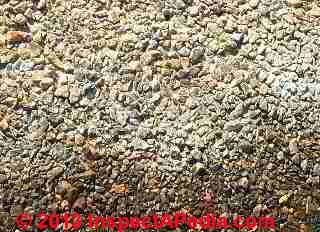 I am confident I have diagnosed the problem correctly. A lot of homeowners here in Albuquerque have swamp coolers--water cooled air conditioners--on their roofs.
I am confident I have diagnosed the problem correctly. A lot of homeowners here in Albuquerque have swamp coolers--water cooled air conditioners--on their roofs.
The staining I have mentioned is directly connected to hard water leaks from these units; hence, the white staining.
I am trying to determine the best chemical solution to use to remove these stains and not a single person I have spoken to has given me a definitive answer.
I clearly value and appreciate your input. Can you suggest a chemical application to remove these ugly white stains prevalent here in ABQ?
Reply: Start Removing White Roof Stains Using the Least-Aggressive, Safest Method - Vinegar Compress
OK now I've got it. Please send me some sharp photos of the stained areas and the swamp cooler - indeed I've looked at this topic in Tucson.
Watch out: don't do anything drastic before we've gotten a bit further in discussion. You don't want to ruin the shingles nor stain and mess up building siding nor contaminate the soil or kill plants around the house with an unnecessarily aggressive chemical treatment.
I am curious about why the white stains are off at roof center and not directly below the swamp cooler.
Anyhow, I would first try a vinegar solution. That is the least aggressive liquid to use, least likely to damage the roof, and least toxic on the ground. Start with maybe a gallon of supermarket white vinegar, diluted 50:50 with water.
Pour it onto the white area and let sit - it will probably fizz. Then wash down the roof with plain water, being sure to wash off plants and also any siding that gets wet.
Reader-Follow-Up: White roof stains traced to previous generation of cooling equipment: swamp cooler
I passed by this home today and also asked myself why the water stain is not lined up with the cooling system.
I assume--after considering that question today--the answer may be that the current cooling system, on the right of the stain, may have been a new system and not the one that may have been sitting where the stain is.
(The current air conditioner on this roof is NOT a swamp cooler; it's refrigerated air--which does not have the water leakage). Hence my assumption.
Anyway, I think that explains it. Plus, there are many homes here who have swamp coolers on the roofs and correlated white stains directly beneath them--so logic tells me it must be the hard water leaking from the swamp coolers.
At any rate, I cannot wait to get up on a roof to test vinegar solution on one of these stains. I am not a gambling man but if I had to I would bet your pretreatment is definitely going to work. Who would have thought vinegar would do the trick? I am so excited. I can't wait to try your treatment out.
I have asked so many so-called roof experts and chemical suppliers about this and they were all puzzled.
At any rate, I will definitely send you before and after photos of the first stain I attempt to clean. If this works, I will be cleaning a lot of roofs this spring as I am starting up a pressure washing business.
Reply: Try stain removal chemicals on a small safe area first
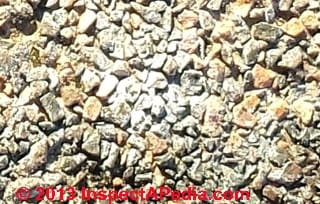 TO be safe, try a small area of the roof first, and have a garden hose handy; you should be ok - we're not doing anything too dramatic. The single most important point, by far, over all, is don't fall off the roof.
TO be safe, try a small area of the roof first, and have a garden hose handy; you should be ok - we're not doing anything too dramatic. The single most important point, by far, over all, is don't fall off the roof.
Reader follow-up: On roof vinegar wash not adequate to remove calcium stains
Absolutely. There are shoes specifically designed to prevent falls called "cougar paws." I just wanted to give you a heads up on my latest attempt to clean the hard water stains from asphalt shingle roofs.
I tried the 50/50 dilution of vinegar in water and it did not do anything.
... One thing I noticed is that the tiny granules on the shingles seem to be almost dyed the color of the calcium!And so I think what might be necessary is to find a more aggressive chemical that can completely remove the white stains from the granules overall.
In any event I tried 2 successive treatments and rinses and of course as I indicated neither one of them were successful.
That said I am attaching a few photographs to give you an idea of what the granules look like that seemed to be almost bleached or dye white by the calcium and water from the swamp cooler.
If you have time and you can give me another option or perhaps direct me to someone who might be able to help me with this perplexing issue I would greatly appreciate it.
Reply: Attacking white mineral deposits on asphalt shingles using stronger acids
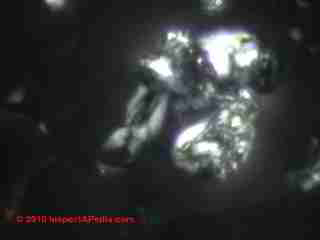 The thing is, you can go to some much stronger stuff like muriatic acid (which is DANGEROUS don't get it on skin or in an eye) but you'll have to be johnny-on-the-spot with rinsing any building or plants that get the acid on them; and it might eat an aluminum gutter or its paint coating too.
The thing is, you can go to some much stronger stuff like muriatic acid (which is DANGEROUS don't get it on skin or in an eye) but you'll have to be johnny-on-the-spot with rinsing any building or plants that get the acid on them; and it might eat an aluminum gutter or its paint coating too.
Photo at left: granules of mineral efflorescence under our lab microscope. Details are
at EFFLORESCENCE SALTS & WHITE DEPOSITS -
Muriatic acid is commonly sold in building supply stores as a masonry cleaner; it's much stronger than vinegar. HCL or hydrochloric acid might also be used.
Reader follow-up:
Great; will do. I am determined to get a solution that works. How long do you suggest I let the muriatic acid sit on the shingle.
And what do you think about what I said regarding the granules appearing to be dyed and completely whitened by the calcium staining.
I guess what I am asking is this: do you think if they have been completely bleached by the hard water that they can still be cleaned by a muriatic based pretreatment.
And by the way, when you say experiment, should I just go ahead and try the muriatic acid without a dilution? Will it burn a hole through my plastic spray bottle?
Reply: Mild or low-concentration roof cleaning acids require more time than stronger more dangerous chemicals
As long as we are convinced that the granules are colored by a deposit of white calcium-like mineral left from an on-roof swamp cooler, then in effect that should be a surface coating, and should be removable.
Pretty much all roof shingle mineral granules are produced by one company (3M if I recall correctly), and are colored-through. But being minerals themselves, the granules may indeed bond well with a calcium layer.
Power washing or scrubbing will, as you've probably read, damage a roof.
But usually an acidic bath will remove a calcium layer. For obvious reasons I like to start with a mild, safe acid like vinegar. A towel soaked with vinegar and left overnight on the white shingles might work without having to resort to more dangerous and difficult acids like muriatic.
When I have used muriatic right from the bottle it was on masonry; in contact with calcium and other debris (fresh mortar) the acid bubbles and fizzes. I wash it off of masonry in 3-5 minutes.
But if you have the time and are willing, try an overnight soaking with vinegar leaving a towel, soaked with vinegar on the roof stain. I doubt that the vinegar will change the non-white-stained granules, and it won't risk harming roofing, nor other building materials.
Reader follow-up: vinegar compress not practical
It would not be practical to have a towel soaking on the shingles overnight for two reasons: One, the stained areas are generally fairly large; and two, because it would take too much time to clean the targeted areas.
(I perhaps should mention I am starting up a cleaning business here in Abq. to pay the bills, and discovered calcium stained roofs may be a good niche market). Hence, my desire get a cleaning application that will work.
At any rate, I am still hopeful I can get a solution or pretreatment application that is fast and effective.
Your suggestions are very helpful and the time you are taking to discuss this topic with me is much appreciated.
I have spoken to someone or should I say communicated with someone who indicated bi carbonated water maybe a viable solution.
Yes. Hi pressure could cause damage. Agreed.
Reply: will carbonated water or seltzer remove white mineral deposits from asphalt shingles?
I'm doubtful but it doesn't hurt to try seltzer on a white stain as it's such a mild treatment. I have used simple carbonated water to clean white salts from battery terminals. Acidic carbon dioxide solutions have been used for stain removal (see Dunsmore citation below). I'm not optimistic that it has the strength to affect the roof, but hell, give it a try.
I went to Muriatic acid (or alternatively to HCL hydrochloric acid) with reluctance as these are dangerous chemicals to mess with - you can get a bad burn.
But the chemistry of carbonated water is a milder than what you already tried (acetic acid or vinegar). Certainly pouring soda water on the roof won't hurt a thing. In a pinch I've used Coke or Pepsi, followed by a water flush to get rid of the sticky mess.
Reader Follow-Up:
Just a quick update. I attempted a muriatic acid solution, beginning with a pint to a gallon of water, let it sit on the shingles and then rinsed. Not much of a reaction, but a slight lightening.
I then used the same process, this time increased the acid to two pints to a gallon. Again progressive lightening.
On my final application, I went all out and added two quarts plus of acid to about a half gallon of water--but again was not successful.
My opinion: since the stains are definitely lightening a bit, I obviously have to move to a more potent/aggressive chemical.
Note: I agitated the acid on each application with a good stiff brush and let it sit on the shingles for 15 minutes before I rinsed during each attempt.
I am sure the stains can be removed, however, there is no way I can make any money cleaning these types of stains if I have to perform multiple chemical applications. I have to find a chemical formula that will remedy the problem on the first, or at the least, second application.
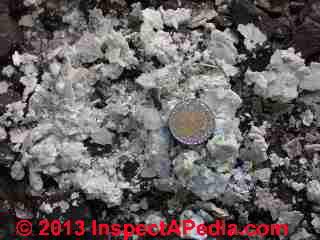 If you have any suggestions, please advise at your convenience. - J.M. 11/13/2013
If you have any suggestions, please advise at your convenience. - J.M. 11/13/2013
More Options for Removing White Stains, Lime and Scale Deposits from Roofs - More about the Chemistry of Lime Scale Deposits & De-Liming Cleaners, Chemicals, Treatments
You are quite right.
I can suggest a few other products to try, based on looking at where else people have tried to remove lime and scale. All of these have the same precautions as muriatic.
Photo at left: lime scale fragments collected from a water heater. [Click to enlarge any image]
Take a look at some boiler cleaning chemicals (and their ingredients)
Noting that some of the info sources I give below want to sell only ridiculously huge quantities, we're interested in what's in them, (the MSDS info sheets often is enough) and trying a couple of representative samples.
These will be available in smaller quantities from a local heating supplier (normally) but for fellow like you who don't work in an area with lots of hot water heating systems you may have to order online.
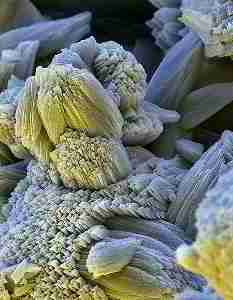 I'd test small quantities of liquid and foam boiler scale cleaning chemicals.
Keep testing to small quantities and small areas for the litany of reasons we've discussed.
I'd test small quantities of liquid and foam boiler scale cleaning chemicals.
Keep testing to small quantities and small areas for the litany of reasons we've discussed.
As lime scale deposits are sometimes reddish, there are also rust-removing cleaners but I am doubtful that it's similar chemistry and so probably less useful.
You can see in Wikipedia's limescale photograph that we're dealing with a hardened calcium/magnesium deposit material, but it is somewhat porous and may be attacked and dissolved by very soft water or more aggressively by cleaners, usually acids.
We've found that for hardened lime deposits a mild approach such as a vinegar poultice is slow and thus not effective for your situation.
Photo: Limescale deposits, SEM scanning electron microscopy micro-graph with a field of view of just 64 x 90 microns.
Source: "Limescale" - Wikipedia, retrieved 11/13/2013
White Stains on Wood Shingle Roofs
The "white stains" shown on this wood shingle roof are in fact not a stain but an absence of lichens or moss.
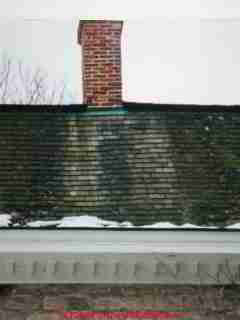 Metal salts washing down the roof surface from metal chimney flashing are often enough to kill of biological organisms that otherwise stain various roof surfaces: algae, lichens, and moss for example.
Metal salts washing down the roof surface from metal chimney flashing are often enough to kill of biological organisms that otherwise stain various roof surfaces: algae, lichens, and moss for example.
The photo at left is an example of roof moss prevention discussed at MOSS on ROOFS. There we commented:
We have observed that the chemical or mineral salt wash-off from some building materials like aluminum flashing and copper flashing and even some paints which appear to kill of moss, lichens, algae, and fungus, as their extracts are washed over the roof surface.
It's particularly easy to spot this effect by noticing where there are moss-free areas on an otherwise mossy roof surface.
One of our most obvious photos of rain wash off of copper flashing keeping moss off of a roof happens to be on a wood shingle roof,
But we see this effect below copper flashing (and often aluminum flashing) on asphalt shingle roofs as well.
There may be cases of wood shingles absorbing water that then evaporates to leave a white stain, but since ulike stone, slate or tile roofing wood shingles don't naturally contain high levels of calcium or magnesium that might be accumlulated on the shingle surface as a white lime deposit, I think that hypothesis is speculative.
Also see: WOOD SHAKE & SHINGLE ROOFING
White Stains on Stone Roofs
The stone roof at above left (Molde, Norway) has some normal light-colored areas that I do not think are a concern.
The white or light gray "stains" on the stone wall at above right can also appear on stone or slate or other roof materials. Lichens is not a stain in the proper sense of the word, but on asphalt, wood, or some other surfaces it can damage the roof and reduce its future life.
Worse, aggressive cleaning of lichens from a roof surface is likely to ruin asphalt roofing and other softer roof coverings.
Also see:
- STONE ROOFING
- STONE, STUCCO & BRICK CLEANING METHODS
- STAINS on SANDSTONE, DIAGNOSE & CURE
- STAINS on STONE, STUCCO DIAGNOSE & CURE
White Stains on Slate Roofs May Indicate Roof Age
White stains formed on roofing slates such as in the roof pictured here are almost always a white mineral salt deposit or effloresence left by the evaporation of water that was absorbed into and that dissolved salts within the roofing slage.
White stains forming on slate roofs (photo above) are interpreted by many slate roofers as an indication of remaining roof life.
As the stained area increases from the perimeter or periphery of the roofing slate towards its center, slate roofers reason that more of the slate area is absorbing water or becoming softer or more porous.
In our experience there is some basis for this view, but because the chemistry and hardness of roofing slates varies significantly from quarry to quarry we are not sure that one can make a quantitative rule about white slate roof stains and remaining life.
Also see:
PAINT on STUCCO, FAILURES also describes white blotches showing up on building surfaces because of improper painting or sealing of masonry or stucco materials. Our Efflorescence article above also diagnoses white stains on chimneys.
White Stains on Tile Roofs Indicate Water Absorption
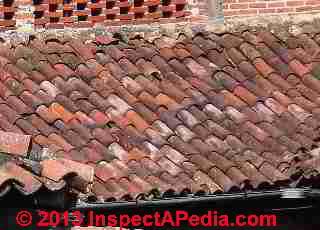 As with the slate roofs discussed above, white stains on tile roofs are typically an efflorescence deposit and may indicate that the tile is absorbing water, thus nearing end of life.
As with the slate roofs discussed above, white stains on tile roofs are typically an efflorescence deposit and may indicate that the tile is absorbing water, thus nearing end of life.
However where we have seen white effloresence staining on clay tile roofs (such as the Mexican clay tile roof photographed below) I have not seen a notable correlation with remaining clay tile roof life.
The amount of water absorption into clay roofing tiles depends on the extent of clay vitrification, in turn an effect of how the clay tiles were fired or produced.
Soft low-vitrification clay tiles such as those shown at above left (Mexico) are more likely to absorb water and would not perform well in freezing climates.
Generally low-vitrified soft clay tile roofs fail due to the fragility of the roofing tiles themselves, not from water absorption and mineral salt formation.
Details about white stains on clay tile roofs are
at CLAY TILE ROOF DAMAGE & WEAR
Or see STAIN DIAGNOSIS on ROOFS for a complete catalog of roof stain sources & causes
Lime removers and de-scaling products
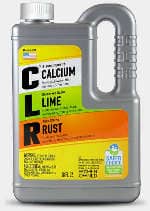 InspectAPedia is an independent publisher of building, environmental, and forensic inspection, diagnosis, and repair information provided free to the public - we have no business nor financial connection with any manufacturer or service provider discussed at our website. We do not sell products nor services.
InspectAPedia is an independent publisher of building, environmental, and forensic inspection, diagnosis, and repair information provided free to the public - we have no business nor financial connection with any manufacturer or service provider discussed at our website. We do not sell products nor services.
- Alibaba boiler cleaners http://www.alibaba.com/showroom/boiler-cleaning-chemicals.html
- "CLR" or "Calcium, Lime, & Rust Remover" is an acidic stain remover, a product of Jelmar Inc., LLC, 5550 W. Touhy Ave. Skokie, IL 60077 USA 1(847) 675-8400.
Its principal ingredients are Lactic Acid and Lauramine Oxide.
Watch out: for this and any other acidic cleaning product be sure to follow the manufacturer's instructions including the company's precautions. The MSDS for CLR warns:
ACUTE EYE IRRITATION (Category 2A)
ACUTE DERMAL IRRATION (Category 4)
DO NOT get in eyes, on skin or clothing.
DO NOT mix with bleach or other household chemicals harmful; fumes may result.
DO NOT ingest.
DO NOT breathe vapor or mist. Use in well ventilated areas. Keep container closed when not in use.
See this Jelmar CLR Calcium Lim Rust Remover MSDS [PDF] retrieved 2018/04/10, original source: https://clrbrands.com/ Jelmar/ media/sds/proline/ CLR-PRO-CALCIUM-LIME-RUST-SDS-64P0216-3-1-17.pdf - Dynamic Lime Remover: http://www.dynamicdescaler.com/?gclid=CICAwc-M4roCFdJ9OgodJnQAzw Dynamic DeScaler - Lime Scale Remover (I contacted the company to ask for a consult in your case and with a wonderfully quick reply we were told no: the company did not recommend their product for cleaning roof surfaces.
They will send you a free sample to try. . The de-scaling or de-liming product is basically aqueous hydrogen chloride (HCL) solution and is described as a "silica remover".
Their DeScale-518 is a phosphoric acid product. Their AquaSafe de-scaler is also a phosphoric acid product. I've asked how these would work on lime deposits on roofs. - Grainger supply (easy to order online) http://www.grainger.com/category/ecatalog/N-1z0dyqp
- LIMEWATER: a simple solution using lime and water - see below
- Simple Green lime scale remover
- Sublime lime scale remover http://www.sublimedescaler.com/sublime-lime-rust-remover.html This is also a hydrochloric acid product. (they also offer a free demo kit)
- Vinegar, household vinegar solution
- I'm also contacting some roofing manufacturers for suggestions but I don't expect much
Other supply sources for de-scalers given that vinegar and similar mild approaches are not working. Lime scale is principally calcium carbonate, possibly also containing magnesium, and sometimes stained reddish from iron content.
Wikipedia has some scattered but useful details: typically acids are used to remove or soften scale. That's why we've been discussing such products. Some sources refer to lime scale or mineral removal using chelation.
A commonly used synthetic chelator is ethylenediaminetetraacetic acid.
Using Lime Water to Remove Scale, White Lime Deposits or Sarro
Finally, also from Wiki, we might later look at lime water softening - but I am very doubtful that it is quick enough to work as a roof cleaning procedure. I quote below (but you can ignore)
Softening can be achieved by adding lime in the form of limewater, Ca(OH)2, which, in a carbonatation reaction with CO2, forms calcium carbonate precipitate, reacts next with multivalent cations to remove carbonate hardness, then reacts with anions to replace the non-carbonate hardness due to multivalent cations with non-carbonate hardness due to calcium.
The process requires recarbonation through the addition of carbon dioxide to lower the pH which is raised during the initial softening process.
As lime is added to raw water, the pH is raised and the equilibrium of carbonate species in the water is shifted. Dissolved carbon dioxide (CO2) is changed into bicarbonate (HCO3-) and then carbonate (CO32-). This action causes calcium carbonate to precipitate due to exceeding the solubility product.
Additionally, magnesium can be precipitated as magnesium hydroxide in a double displacement reaction.
The process is interesting in that both the calcium (and to an extent magnesium) in the raw water as well as the calcium added with the lime are both precipitated. This is in contrast to ion exchange softening where sodium is exchanged for calcium and magnesium ions. In lime softening, there is a substantial reduction in total dissolved solids (TDS).
In ion exchange softening (sometimes referred to as zeolite softening), there is no significant change in the level of TDS.
Lime softening can also be used to remove iron, manganese, radium and arsenic from water. - Wikipedia, Lime Softening, retrieved 11/13
Reader update:
I contacted Graingers and they recommended a product called "Calcium and Lime Remover," item # 4tmk3. This product contains phosphoric acid; not sure if it's compatible with asphalt? do you suggest I give it a try? The spokesperson I talked with said sulfuric acid may be the way to go?
Also sent an email to the folks in Texas and requested information on the sublimedescaler product and a demo kit. I am also going to research boiler cleaning chemicals and distributors. Again, I am convinced there is a solution out there; it just feels like finding snow in the summer in Albuquerque may be easier!
Reply:
I'd try the HCL or phosphoric acids first. The various products I reviewed with that acid claimed those were safer to work with.
Watch out: While working with any acid solution can be dangerous, Sulphuric acid is really dangerous in concentration. I learned as a kid to repeat
Johnny was a good boy, but Johnny is no more, for what he thought was H2O was H2SO4.
References for Cause & Cure of White Calcium or Mineral Stains on Roofs
- Allanbrook, Timothy, and Kyle C. Normandin. "The Restoration of the Fifth Avenue Facades of the Metropolitan Museum of Art." APT BULLETIN-FREDERICKSBURG VA- 38, no. 4 (2007): 45.
- Berdahl, Paul, Hashem Akbari, Ronnen Levinson, and William A. Miller. "Weathering of roofing materials - an overview." Construction and Building Materials 22, no. 4 (2008): 423-433. [White oxide formation on wood roofing]
- Bigham, W. Stuart, Christine A. Sobon, and Billy L. George. "Tin-acrylate-containing polymers as algicidal agents in building materials." U.S. Patent 5,573,782, issued November 12, 1996. [ similar topic to Skadulis]
- Brightman, F. H. "Some factors influencing lichen growth in towns." Lichenologist 1, no. 3 (1959): 104.
- Burroughs, James E., and James A. Nowak. "Composition and method for removing insoluble scale deposits from surfaces." U.S. Patent 3,951,827, issued April 20, 1976.
- Carr, Charles W. "Resaturation of asphalt shingles." U.S. Patent 6,495,074, issued December 17, 2002. [Doubtful]
- Del Monte, Marco, Cristina Sabbioni, and Giuseppe Zappia. "The origin of calcium oxalates on historical buildings, monuments and natural outcrops." Science of the total environment 67, no. 1 (1987): 17-39.
- Dunsmore, H. E. "A geological perspective on global warming and the possibility of carbon dioxide removal as calcium carbonate mineral." Energy Conversion and Management 33, no. 5 (1992): 565-572.
- Fast, Clarence B. "Removing Deposits from Wells" U.S. Patent 2,596,137, issued May 13, 1952.
- Gaylarde, Christine, and Glyn Morton. "Biodeterioration of mineral materials." Encyclopedia of environmental microbiology (2002). [Help for the green-roof enthusiasts]
- Lesinsld, Chester A. "SCALE REMOVAL, FERROUS METAL PASSIVA-TION AND COMPOSITIONS THEREFOR." U.S. Patent 3,308,065, issued March 7, 1967. [discusses using HCL hydrochloric acid for white stain deposit removal]
- Lesinski, Chester A. "Scale removal, ferrous metal passivation and compositions therefor." U.S. Patent RE30,796, issued November 17, 1981.
- Mcmahon, William A. "ZINC CONTAINING ALGICIDAL SURFACING, METHOD, AND GRANULES." U.S. Patent 3,507,676, issued April 21, 1970.
- Ortega-Morales, Benjamin Otto, Christine Claire Gaylarde, Gelsa Edith Englert, and Peter Michael Gaylarde. "Analysis of salt-containing biofilms on limestone buildings of the Mayan culture at Edzna, Mexico." Geomicrobiology journal 22, no. 6 (2005): 261-268.
- Payne, Mark Allan, and Aaron Goodman. "SYSTEM AND METHOD FOR FACILITATING ON-SITE STAIN REMOVAL." U.S. Patent Application 13/004,434, filed January 11, 2011. [Not specific to roofs]
- Rasmason, Steven C. "Warning alarm device for an evaporative cooler." U.S. Patent 5,365,220, issued November 15, 1994. [Discusses swamp cooler overflow conduit onto roof surface]
- Skadulis, Amis. "COPPER COMPOUND-CONTAINING ALGICIDAL SURFACING AND PROCESS." U.S. Patent 3,528,842, issued June 26, 1970. [focuses on the algae problem not mineral salt deposits]
- Villanueva, Robert. "Drain hose assembly." U.S. Patent 5,746,950, issued May 5, 1998. [Drain hose patent]
- Webster, Alison, and Eric May. "Bioremediation of weathered-building stone surfaces." TRENDS in Biotechnology 24, no. 6 (2006): 255-260.
Reader Comments, Questions & Answers About The Article Above
Below you will find questions and answers previously posted on this page at its page bottom reader comment box.
Reader Q&A - also see RECOMMENDED ARTICLES & FAQs
On 2018-04-10 by Diana
Try CLR on the stains, it removes calcium, lime, and sulfate.
On 2015-11-10 by (mod) -
Gee What; we suggest some common sources of white roof stains in the article above. With just your question I don't know what else to suggest.
On 2015-11-10 by what is it. need help
Need help
On 2015-09-27 by CentralPACrist
I have lime buildup on my blacktop driveway from watering the lawn. How can I remove? And be safe enough for any mist/over-sprays onto the lawn/grass? Thanks!
On 2014-02-12 by (mod) -
I will look for the photos, comment, and add the discussion and images here in case other readers have a useful comment to offer. DF
On 2014-02-08 by (mod) -
Got em, sent you a long reply, and will post the discussion here.
If you think this white stuff is mold (mildew is a small subset of molds that grows ONLY on living plants so even though people use that word, it's mold, not mildew if it's on a roof) I ought to be able to identify it in our lab - send me a most-suspect sample - I just need a few square inches if the stain is plainly visible.
On 2014-02-08 by Shane
I just emailed the pictures. I have a some more I took off my PC at work I can send as well. I met my roofer out there and we pulled some stained shingles out and pulled some shingles that were still black-ish. It looks to me like these 7-8 year old black shingles that appear to be stains are just clean and free of mildew.
There are some other homes that appear to have grey roofs and they are really just clean roofs the home owners had them cleaned. I am going to clean a few sections of the shingles I pulled out and see what happens.
On 2014-02-07 by (mod) -
I look forward to seeing some photos - both closeups of stains and from enough distance that I can understand the building and its site. If the stains were a salt we'd still need to understand why they appear where they do and not elsewhere on the roof.
On 2014-02-07 by Shane
I will get some fresh pictures tomorrow and send them. The majority of the staining is at the stucco areas but it extends out past the stucco and is above the stucco. It almost looks like mass amounts of bird droppings that has washed down over time.
Some of these homes has stucco repairs on them but these stains were photographed before the stucco work was done. My first thought was either chalking from the paint or some sort of efflorescent from the stucco bleeding the paint. When pressure washed I can see how the chalky paint would extend past the stucco.
Salt does make sense, this is a coastal area. Could the paint absorb environmental fall out in the form of air born salts? Can that actually happen.
On 2014-02-06 by (mod) - weird white stains on the Black Asphalt shingles
Shane,
If you can send me some photos I might have an idea - use the CONTACT link found at page top or bottom.
Effloresence is a salt deposit left by evaporating water; we'd need to think that there was a reason for water in the stain areas to be higher in salts than other water running down other roof areas.
so thinking ...
If the stains are directly below white siding, such as painted clapboards or white aluminum siding, I'd suspect it was pigment from wearing, washing-down paint coating.
On 2014-02-06 by Shane
Hello!
I have around 150 homes in my community that have these weird white stains on the Black Asphalt shingles. The stains are only found to the sides and below dormers or anywhere else there is stucco. The homes are built between 2004-2007 and have been repainted by the HOA between years 5-6.
It was first noticed just before the first repaints and on some of the first repainted homes it has gotten worse.
There are 300 homes that are not effected. We are located in Melbourbe Florida about 4-5 miles inland form the Atlantic ocean. Could this be from efflorescent or salt deposits?
...
Continue reading at EFFLORESCENCE SALTS & WHITE DEPOSITS or select a topic from the closely-related articles below, or see the complete ARTICLE INDEX.
Or see these
Recommended Articles
- EFFLORESCENCE: WHITE DEPOSITS on ROOFS
- SCALE PREVENTION, WATER HEATER
- STAIN DIAGNOSIS on ROOFS for a complete catalog of roof stain sources & causes
- WATER HARDNESS: HOW TO DETECT
- WATER HARDNESS: HOW TO MEASURE
- WHITE STAINS on ROOFS.
Suggested citation for this web page
WHITE STAINS on ROOFS at InspectApedia.com - online encyclopedia of building & environmental inspection, testing, diagnosis, repair, & problem prevention advice.
Or see this
INDEX to RELATED ARTICLES: ARTICLE INDEX to BUILDING STAINS
Or use the SEARCH BOX found below to Ask a Question or Search InspectApedia
Ask a Question or Search InspectApedia
Try the search box just below, or if you prefer, post a question or comment in the Comments box below and we will respond promptly.
Search the InspectApedia website
Note: appearance of your Comment below may be delayed: if your comment contains an image, photograph, web link, or text that looks to the software as if it might be a web link, your posting will appear after it has been approved by a moderator. Apologies for the delay.
Only one image can be added per comment but you can post as many comments, and therefore images, as you like.
You will not receive a notification when a response to your question has been posted.
Please bookmark this page to make it easy for you to check back for our response.
Our Comment Box is provided by Countable Web Productions countable.ca
Citations & References
In addition to any citations in the article above, a full list is available on request.
- [1] Joe Miceli Clean Right 505-506-1511 Miceli571@gmail.com Commercial, and Residential Pressure Washing Solutions.
- Allanbrook, Timothy, and Kyle C. Normandin. "The Restoration of the Fifth Avenue Facades of the Metropolitan Museum of Art." APT BULLETIN-FREDERICKSBURG VA- 38, no. 4 (2007): 45.
- Berdahl, Paul, Hashem Akbari, Ronnen Levinson, and William A. Miller. "Weathering of roofing materials - an overview." Construction and Building Materials 22, no. 4 (2008): 423-433. [White oxide formation on wood roofing]
- Bigham, W. Stuart, Christine A. Sobon, and Billy L. George. "Tin-acrylate-containing polymers as algicidal agents in building materials." U.S. Patent 5,573,782, issued November 12, 1996. [ similar topic to Skadulis]
- Brightman, F. H. "Some factors influencing lichen growth in towns." Lichenologist 1, no. 3 (1959): 104.
- Burroughs, James E., and James A. Nowak. "Composition and method for removing insoluble scale deposits from surfaces." U.S. Patent 3,951,827, issued April 20, 1976.
- Carr, Charles W. "Resaturation of asphalt shingles." U.S. Patent 6,495,074, issued December 17, 2002. [Doubtful]
- Del Monte, Marco, Cristina Sabbioni, and Giuseppe Zappia. "The origin of calcium oxalates on historical buildings, monuments and natural outcrops." Science of the total environment 67, no. 1 (1987): 17-39.
- Dunsmore, H. E. "A geological perspective on global warming and the possibility of carbon dioxide removal as calcium carbonate mineral." Energy Conversion and Management 33, no. 5 (1992): 565-572.
- Fast, Clarence B. "Removing Deposits from Wells" U.S. Patent 2,596,137, issued May 13, 1952.
- Gaylarde, Christine, and Glyn Morton. "Biodeterioration of mineral materials." Encyclopedia of environmental microbiology (2002). [Help for the green-roof enthusiasts]
- Lesinsld, Chester A. "SCALE REMOVAL, FERROUS METAL PASSIVA-TION AND COMPOSITIONS THEREFOR." U.S. Patent 3,308,065, issued March 7, 1967. [discusses using HCL hydrochloric acid for white stain deposit removal]
- Lesinski, Chester A. "Scale removal, ferrous metal passivation and compositions therefor." U.S. Patent RE30,796, issued November 17, 1981.
- Mcmahon, William A. "ZINC CONTAINING ALGICIDAL SURFACING, METHOD, AND GRANULES." U.S. Patent 3,507,676, issued April 21, 1970.
- Ortega-Morales, Benjamin Otto, Christine Claire Gaylarde, Gelsa Edith Englert, and Peter Michael Gaylarde. "Analysis of salt-containing biofilms on limestone buildings of the Mayan culture at Edzna, Mexico." Geomicrobiology journal 22, no. 6 (2005): 261-268.
- Payne, Mark Allan, and Aaron Goodman. "SYSTEM AND METHOD FOR FACILITATING ON-SITE STAIN REMOVAL." U.S. Patent Application 13/004,434, filed January 11, 2011. [Not specific to roofs]
- Rasmason, Steven C. "Warning alarm device for an evaporative cooler." U.S. Patent 5,365,220, issued November 15, 1994. [Discusses swamp cooler overflow conduit onto roof surface]
- Skadulis, Amis. "COPPER COMPOUND-CONTAINING ALGICIDAL SURFACING AND PROCESS." U.S. Patent 3,528,842, issued June 26, 1970. [focuses on the algae problem not mineral salt deposits]
- Villanueva, Robert. "Drain hose assembly." U.S. Patent 5,746,950, issued May 5, 1998. [Drain hose patent]
- Webster, Alison, and Eric May. "Bioremediation of weathered-building stone surfaces." TRENDS in Biotechnology 24, no. 6 (2006): 255-260.
- NRCA - National Roofing Contractors Association - Website: www.nrca.net 10255 W. Higgins Road, Suite 600, Rosemont, IL 60018-5607, Tel: (847) 299-9070 Fax: (847) 299-1183
- Wikipedia Web: https://www.wikipedia.org/ provided background information about some topics discussed at this website provided this citation is also found in the same article along with a " retrieved on" date. NOTE: because Wikipedia entries are fluid and can be amended in real time, we cite the retrieval date of Wikipedia citations and we do not assert that the information found there is necessarily authoritative. Lime Softening, retrieved 11/13/2013
- Our recommended books about building & mechanical systems design, inspection, problem diagnosis, and repair, and about indoor environment and IAQ testing, diagnosis, and cleanup are at the InspectAPedia Bookstore. Also see our Book Reviews - InspectAPedia.
- In addition to citations & references found in this article, see the research citations given at the end of the related articles found at our suggested
CONTINUE READING or RECOMMENDED ARTICLES.
- Carson, Dunlop & Associates Ltd., 120 Carlton Street Suite 407, Toronto ON M5A 4K2. Tel: (416) 964-9415 1-800-268-7070 Email: info@carsondunlop.com. Alan Carson is a past president of ASHI, the American Society of Home Inspectors.
Thanks to Alan Carson and Bob Dunlop, for permission for InspectAPedia to use text excerpts from The HOME REFERENCE BOOK - the Encyclopedia of Homes and to use illustrations from The ILLUSTRATED HOME .
Carson Dunlop Associates provides extensive home inspection education and report writing material. In gratitude we provide links to tsome Carson Dunlop Associates products and services.


